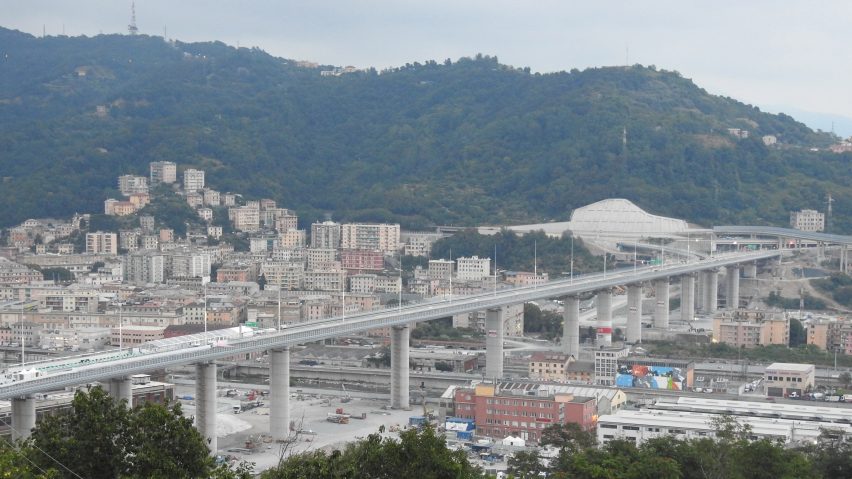Renzo Piano's Genoa San Giorgio Bridge, which is the replacement for the Morandi Bridge that collapsed in a storm almost two years ago, has opened in Italy.
Built in Piano's home town of Genoa, the 1,100-metre-long motorway bridge was inaugurated by the Italian prime minister almost exactly two years after the previous bridge collapsed on 14 August 2018 killing 43 people.
The design and build of the new bridge over the Polcevera river and the area of Val Polcevera was completed in less than two years following round the clock construction.
"Its rapid reconstruction aims to become a model for the renovation and adaptation of Italian infrastructure with a high social, economic and strategic significance," said Piano's studio Renzo Piano Building Workshop.
Described by the studio as an "urban bridge", the bridge's deck is supported by 18 slender reinforced concrete piers spaced 50 metres apart except in the central section where they are separated by 100 metres.
Each of the piers has an elliptical section designed to allow the light to "slip" on the surface and help mitigate the impact on the neighbourhood below.
The piers support a steel and concrete deck that is isolated by a system of support devices that are designed to protect the structure from seismic activity.
According to Piano's studio, the underside of the deck is curved to be reminiscent of the form of a ship.
"From an architectural point of view, the form described by the deck, which recalls the hull of a ship, is of great importance," said the studio.
"The gradual reduction of the section towards the ends of the bridge attenuates the visual impact of the new infrastructure. In addition, the use of a light colour for the coating of the steel elements makes the bridge bright, harmonising its presence in the landscape."
Along the sides of the bridge deck are a series of metal fins that extend from the bridge's steel structure along with rows of photovoltaic panels that will power its lighting and a 2.5-metre-high protective glass barrier.
"The transparency of the glass and, consequently, the extreme visual permeability that derives from it, makes it possible to observe the surrounding landscape by crossing the new bridge, as well as lightening its presence in the valley for those who will live it from the city," said the studio.
Described as an "intelligent instrument" by the studio the bridge will be continuously monitored using a system of internal sensors including accelerometers, extensometers, velocimeters, inclinometers and detectors for joint expansion.
These sensors will be supplemented by robots that will run along rails on the bridge's edge to monitor the superstructure externally and will also clean the photovoltaic panels.
The Genoa San Giorgio Bridge replaces the Morandi Bridge, which was completed in 1974 and was a local landmark in the city of Genoa.
Designed by Italian engineer Riccardo Morandi, the cable-stayed bridge was completed in 1967 and had an unusual structure as it was a concrete cable-stayed bridge.
As part of the plan to rejuvenate of the area under the collapsed bridge, Stefano Boeri has designed elevated walkway as part of the Polcevera Park and The Red Circle masterplan.
Photography is by Shunji Ishida.
Project credits:
Concept and supervision: Renzo Piano
Technical project: Italferr
General contractor: Pergenova ScpA
Project & construction management and quality assurance: Rina Consulting SpA
Lighting consultants: iGuizzini
Client: Commissario ricostruzione Genova

